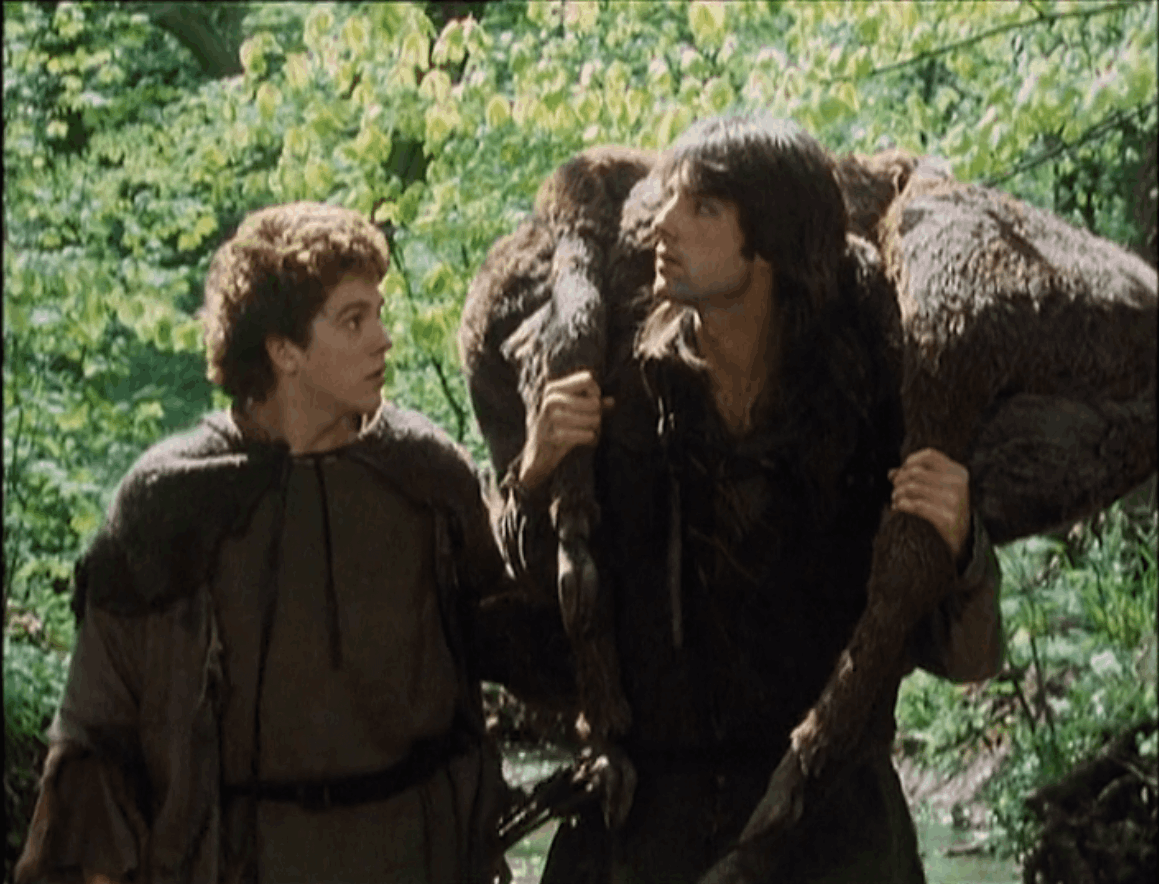
Richard Carpenter undoubtedly did a fair amount of research into existing Robin Hood stories when creating Robin of Sherwood. But there is one specific work that was clearly an influence - the popular children's novel of Robin Hood by Evelyn Charles H. Vivian (the favoured pseudonym of Charles Henry Cannell). An edition of this book was published in 1927 and it was reprinted (and translated) several times.
While some things can be explained away as coincidence or parallel storytelling, the names Robert and Hugo de Rainault for the Sheriff of Nottingham and his brother the Abbot of St. Mary's occuring in both the novel and the TV series is definitive proof of a connection. Names like Baleme, Dark Mere and Ravenscar further show the ties between the book and Robin of Sherwood. I'll be pointing out some of the incidents below.
But while Richard Carpenter borrowed some names and incidents from Vivian's novel, there's a great deal more that is different. Perhaps most obviously, aside from a few haunted whispers about Sherwood Forest, Vivian's novel lacks the myth and magic of Robin of Sherwood. No antlered deities (or avatars of deities) called Vivian's Robin to action. Simon de Belleme is a sorcerer, but his literary predecessor Isambart de Baleme is just another vicious Norman robber baron, one of long line of similar villains in 19th and 20th century Robin Hood fiction. Also, Vivian's novel lacks much of the humour and warmth that Carpenter and the actors and directors brought to Robin of Sherwood.
* A tip of the bycocket to Margaret Carspecken, whose Shadows of Sherwood page on the Ozfox website first brought the E.C. Vivian connections to my attention.

It's only natural that Robin of Sherwood would borrow from earlier versions of the legend. Elements from the original ballads have appeared in nearly every Robin Hood film or TV series. Some of the connections are deliberatre references to the 600 year plus literary tradition. Other times it's sheer coincidence. I very much doubt that Anthony Horowitz had an episode of Rocket Robin Hood in mind when he wrote "The Sheriff of Nottingham", but it's fun to note the similarity.
As I started this in 2011, I was feeling guilty that I left out all the non-Robin Hood sources. Fortunately, I believe Andrew Orton's Hooded Man books should pick up my slack and provide more information in the bargain. But I'd like to think I might turn up the odd connection or two that he missed. (The first volume arrived as I was making the final revisions to this section, and to his credit Andrew Orton catches an awful lot.)
* A note on episode order. Between the UK broadcast, US broadcast (Showtime and PBS), VHS, DVD and Blu-Ray releases, the episodes of the second and third series have been arranged in many different orders. My own preference is the one I was first exposed to -- that of WNED in Buffalo (which opens the 2nd season with "The Prophecy" as did the original UK airing) but that is based on nostalgia rather than logic. For the purpose of this list, I've chosen the "author's prefered order" from the Blu-Ray release.
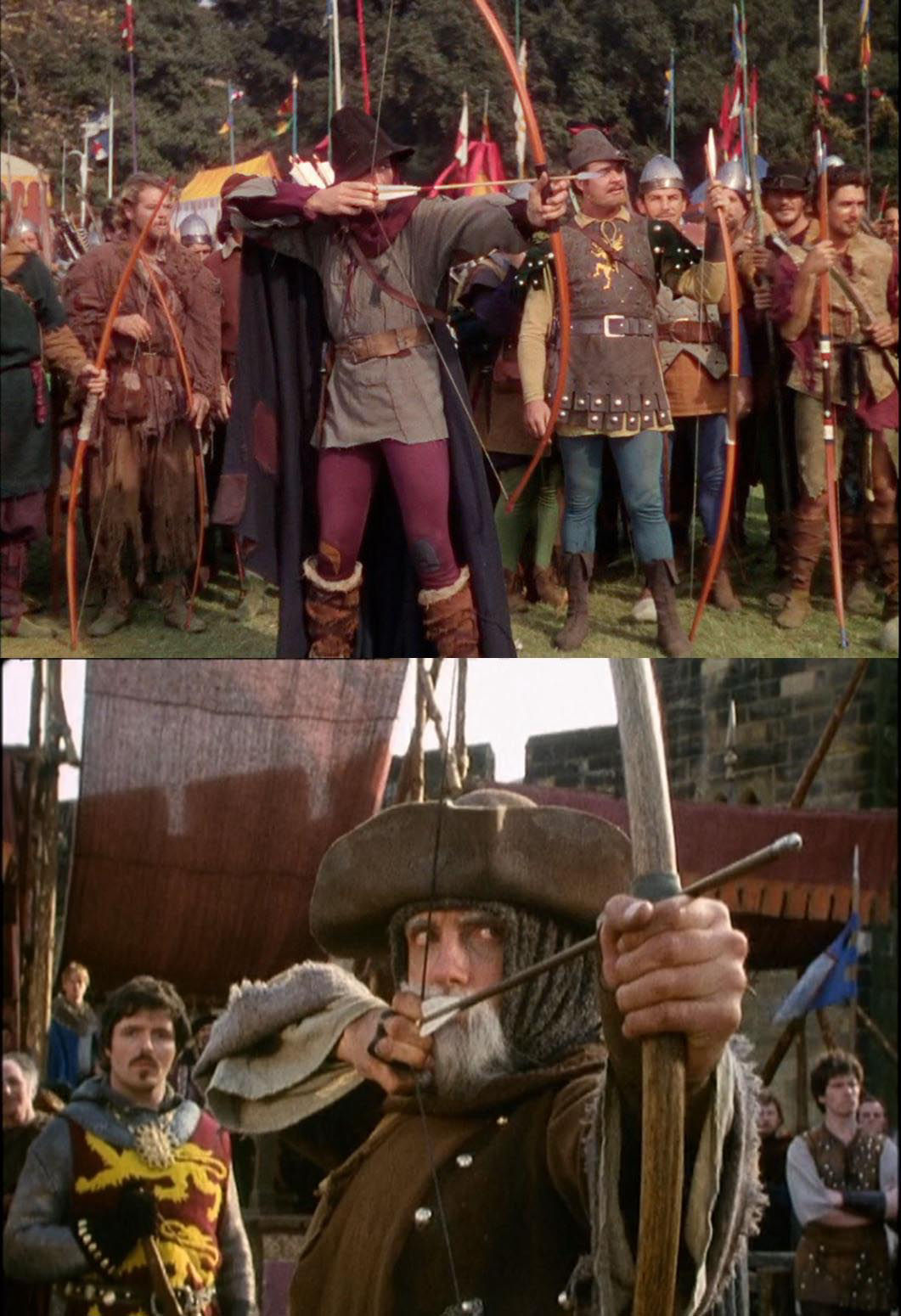
Robin Hood and The Sorcerer (Parts 1 and 2):
As the episodes that lay the foundations for the series, these two episodes borrow quite a lot from the legend of Robin Hood. The archery contest appears in A Gest of Robyn Hode, one of the earliest surviving ballads, and also in the later ballad Robin Hood and the Golden Arrow. It's in Sir Walter Scott's 1819 novel Ivanhoe that Robin splits the arrow, a visually dramatic moment used in many films including 1938's The Adventures of Robin Hood starring Errol Flynn.
The Flynn film influenced the structure of many Robin Hood films and TV shows to follow including this episode. While Robin defended someone from foresters in Leigh Hunt's 19th century verse narratives and Henry Gilbert's and E.C. Vivian's children's novels, it was when Robin rescued Much at beginning of the 1938 film that this incident was firmly placed in the film cannon. Robin also rescues Much from a forester in the first episode of the 1955 TV series starring Richard Greene. The 1969 failed TV pilot / 1973 film Wolfshead begins with Robin defending Gyrth from foresters, and the 1975 TV series The Legend of Robin Hood shows Robin failing to rescue a peasant from a knight. After Robin of Sherwood, 1991's Robin Hood starring Patrick Bergin and the 2006 Tiger Aspect/BBC series opened with Robin saving a future band member from foresters, and the rescue of Little John's son from a similar fate was a minor part of the 1991 Kevin Costner film Robin Hood - Prince of Thieves.
The idea of Robin being fostered comes from the mythic elements added to the show, but it's not without precedent in the legend. In both Pierce Egan's 1839 serialized novel Robin Hood and Little John (translated into French as Robin Hood, Prince Des Voleurs supposedly by Alexandre Dumas and subsequently translated back into English due the French author's fame) and the 1975 TV series The Legend of Robin Hood, Robin is really the heir of the earldom of Huntingdom, fostered to commoners.
Robin's quarterstaff duel with Little John comes from the ballad Robin Hood and Little John, and similar scenes appear in most Robin Hood novels, films and TV shows. As detailed above, the most specific influence on these episodes would be E. C. Vivian's early 20th century children's novel. Robin Hood recycles Vivian's names for the sheriff and abbot (Robert and Hugo de Rainault), the scene with the sword on a string and the whole plot of Marion being forced to marry a villain named Belleme.
Here is a passage from Chapter V "Guy of Gisborne's First Attempt" from Vivian's Robin Hood novel
"And what do I get if I pend you thirty men?" Isambart asked.
"You get the honour of helping Holy Church at need," said the Abbot.
Isambart smiled craftily. "A cheap reward," he remarked. "Good Hugo, since my wife died I am a lonely man in my castle of Belame. If I give you my help in this matter, you shall give me your ward Marian, who is under shelter at Kirklees with the Abbess there, but is none the less yours to give to any man you will."
"Ha!" said the Abbot. "This is a great reward you ask."
"Truly great," Isambart agreed, "for you thought to make a nun of Marian and take all her broad lands to add to yours of St. Mary's. But she is too beautiful to be a nun, would better be wife to me."
"It is too much to ask," the Abbot said.
"So be it," Isambart replied, "but when this bold outlaw is burning your Abbey over your head you will wish you had paid the price of my thirty men before he set fire to you."
The abbot does give into Isambart's terms fairly quickly, but it is all for nothing as Robin outwits Guy. Now, here's the corresponding scene in Robin of Sherwood. Marion comes before the visiting Baron Simon de Belleme. The Sheriff of Nottingham and his brother Abbot Hugo are present.
BELLEME: You are the daughter of Sir Richard at the Lee.
MARION: Yes, my lord baron.
SHERIFF: Killed in Palestine, my lord.
BELLEME: And are now the ward of the Abbot Hugo.
MARION: Yes, my lord baron.
BELLEME: And you live here in Nottingham Castle under ... the protection of his brother.
MARION: Yes, my lord baron.
BELLEME: You are very fortunate to have two such devoted guardians.
Marion looks uncomfortable.
BELLEME: A year ago, the Lady de Belleme took her own life. You could take her place.
MARION: I am honoured, my lord. But I'm afraid I can't.
SHERIFF: What?
MARION: Within this month I go to Kirklees Abbey ... to become a novice of the order.
ABBOT HUGO: My Lord, you must understand...
BELLEME: Marry her to God? So that her lands come to the church?
ABBOT HUGO: My Lord, I ..
BELLEME (chuckles): The time is coming when you will beg for my help. Both of you. You'll give her to me then ... when the Hooded Man comes to the forest.
The Witch of Elsdon:
Only implicit in the episode, but explicit in the novelization, Gisburne begins as Abbot Hugo's steward, but transfers allegiences to the sheriff. In E. Charles Vivian's 1927 novel, Sir Guy was also Abbot Hugo's steward. Also, that Robin defeats Sir Guy and wears his clothes to trick the sheriff evokes the medieval ballad Robin Hood and Guy of Gisborne and the similar dramatic fragment from 1475 (where Robin's opponent is unnamed). Robert Addie's Guy of Gisburne both more fashionable and luckier than his ballad counterpart. In the ballad, Gisborne wore a more distinctive costume - a horse's hide - and was decapitated by Robin (who then slashed the severed head to make it unrecognizable). Marian also appears to have some skill with potions and medicines, an aspect perhaps carried over from Vivian's novel.
Seven Poor Knights from Acre:
The capture of one of Robin’s band is a common trope from the ballads to the films, most notably in the original Guy of Gisborne ballad,
Robin Hood Rescuing Will Stutly and Robin Hood Rescuing Three Squires. Sir Walter Scott’s 1819 novel Ivanhoe had an enormous impact on the Robin Hood legend and the conflicted villain Sir Brian de Bois-Guilbert is a Templar, and a trial-by-combat occurs in front of the Templar’s Grand Master. The Knights Templar also appear in Scott’s later novel The Talisman. Also, a potter who Robin “helped” appears. One of the earliest ballads features Robin fighting a potter and assuming his identity to play a trick on the sheriff.
Alan a Dale:
This episode is slightly more comic take on a well-known 17th century balllad Robin Hood and Allen a Dale, which has been adapted in many Robin Hood novels and some films such as 1948's The Prince of Thieves (adapted from the Alexandre Dumas novel of the same name, which itself was borrowed from Pierce Egan's earlier novel, and unconnected with the 1991 film of the same name). The Robin Hood of E.C. Vivian's novel also weaponizes bees (to rescue Will Scarlett), and in the 2010 film Friar Tuck makes similar use of his bees.
The King's Fool:
Robin Hood is pardoned by King Edward in the 15th century ballad A Gest of Robyn Hode. The same basic story appears in the Forresters Manuscript of 1670 and the later 18th century ballad The King’s Disguise and Friendship with Robin Hood where the king is now Richard. The story was a popular one and incorporated into many novel and film versions of the legend. However, in the Gest, Robin leaves the king’s service after 15 months and goes back to his outlaw ways. He doesn’t do this because the king is particularly evil (as in Robin of Sherwood, and somewhat with the soon-deceased King Richard in the 1976 film Robin and Marian). Rather the Robin of the early ballads couldn’t function in court society and lost his all his money and joie d’vivre. (Also, like in this episode, most of Robin’s men had left him.) Most modern version either end with Robin’s pardoning or have it rescinded only when King John comes to the throne. In Sir Walter Scott’s 1819 novel Ivanhoe, the king takes on the disguise of a black knight rather than an abbot. This change was adopted in later works such as the novels of Evelyn Charles Vivian, Roger Lancelyn Green and of course, “The King’s Fool”. Will’s refusal to go to Nottingham slightly echoes Will’s break with Robin in the medieval ballad Robin Hood’s Death.
The episode also takes more from real history than many Robin Hood stories do, as Richard did indeed hold a council in Nottingham in the spring of 1194 where he turfed people from their offices (noting they had been on lease) and resold them to the highest bidders.
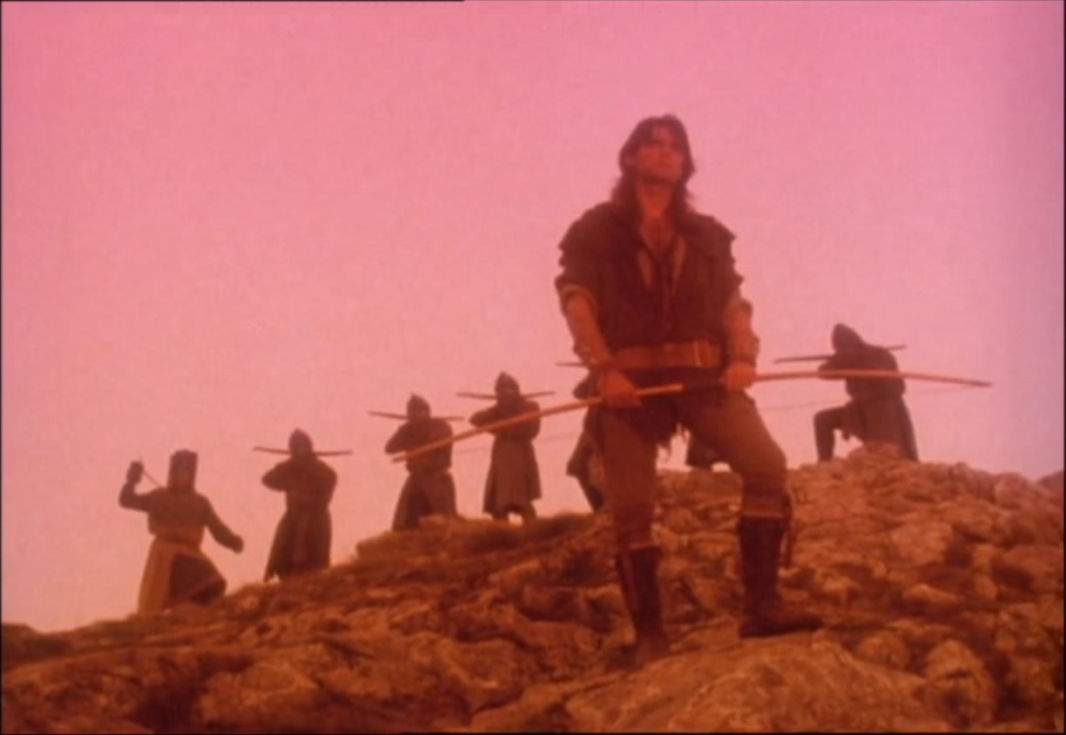
The Swords of Wayland (Parts 1 and 2):
The real-world Ravenscar is in North Yorkshire, far removed from the apparent West Country setting of the episode. However, the name appears in E. Charles Vivian's novel (yes, again). In the novel, Robin and his men vote on whether to cross England to help a village under attack from an evil pirate named Damon the Monk. (Vivian was probably inspired by ballad known as Robin Hood's Fishing or The Noble Fisherman, depending on its version.) In the ballad and storybook tradition, it was an evil churchwoman responsible for Robin Hood's death, the Prioress of Kirklees. Morgwyn of Ravenscar may come from that tradition, and 'The Swords of Wayland" certainly inspired a later depiction of Kirklees. In the 1997 TV series The New Adventures of Robin Hood, Kirklees Abbey appears in the first season episode "Witches of the Abbey" as home to three witches (lead by Robin's aunt, the evil Abbess Alice) who bewitch Little John into being their servant. New Adventures features many devil-worshipping villains, including Robert Addie as servant to the Irish devil Balor.
The Prophecy:
As mentioned in "Seven Poor Knights From Acre" section, Robin Hood rescuing a band member (or being rescued himself) is a long-running trope of the legend. In particular, this episode borrows heavily from Evelyn Charles Vivian’s novel Robin Hood Chapters XIV, XV and XVI detail the capture and rescue of Will Scarlett, but when they free Will, the Merry Men also rescue an imprisoned Sir Richard, Marian’s father who had supposedly been killed on the way to the crusade years earlier. A traitor is also freed, William, who reveals the location of Robin’s camp to the villains. King Richard’s death at Chalus was depicted on screen in 1976 film Robin and Marian and again in the 2010 Robin Hood movie.
Lord of the Trees:
The mummer’s play of St. George that Robin, Little John, Will and Tuck perform to beguile the mercenaries is similar to the plays performed at May Games celebrations. Performances of Robin Hood stories were a common feature at such festivals in later centuries. The healing of “St. George” vaguely resembles the original Robin Hood and Guy of Gisborne ballad (which itself strongly resembles dramatic fragment of 1475 performed at such festivals) where Robin is badly wounded by Sir Guy but revives after he prays to the Virgin Mary. In many novels, including that of E.C. Vivian, characters are unnerved by the dark tales of the forest.
The concluding chapters of Henry Gilbert's 1912 novel Robin Hood and the Men of the Greenwood are set after the signing of Magna Carta, when King John has foreign mercenaries -- including Flemings and Brabanters invade England to support his cause. Robin fights a duel to the death with the Brabanter captain Fulco the Red.
The Children of Israel:
The argument between Will Scarlet and Robin reflects Robin’s disagreements with his band in some of the earliest ballads. Will Scarlett quarreled with Robin and left his service in an early version of Robin Hood’s Death. More notably, Little John temporarily left Robin’s service in the 15th century ballad Robin Hood and the Monk largely due to Robin's own poor behaviour. However, Little John rescues Robin Hood, and in recognition of this, Robin make Little John the leader of the band, but he refuses this honour, wanting Robin to remain as leader. The tension between Robin and his band can also be seen in the "Goodbye, Little John" episode of the 1950s TV series The Adventures of Robin Hood, where John temporarily quits the group because he feels Robin relies more on Will Scarlett than him. Guy’s unwanted interest in Sarah resembles Sir Brian de Bois-Guilbert’s obsession with Rebecca in Sir Walter Scott’s Ivanhoe. Will Stutely aka Will the Bowman came upon a young Jewish woman and her father who had fled the historical persecutions in London and York in Henry Gilbert's 1912 novel Robin Hood and the Men of the Greenwood. The sheriff refuses to launch an anti-semitic attack in Nottingham, and Robin is also far less merciful to the enemies in the novel. Anti-semitism was also featured in "The Wanderer" and "The York Treasure" episodes of the 1950s TV series starring Richard Greene.
Again in the "The York Treasure", the sheriff shows no sign of anti-semitism initially resisting any attempt to attack the Jews arriving in Nottingham, until the guest villain finally wins him over with promises of riches and appealing to the sheriff's loyalty to Prince John (the normal reasons for his villainy). In Gilbert's novel and the 1950s TV series, even the sheriff's evil had its standards.
The Enchantment:
While love potions and illusionary homes belong more to the Arthurian mythos than the Robin Hood legend, Robin has fought illusion-casting witches before. Most notable is Ben Jonson’s unfinished (well, unfinished by Jonson – later writers have supplied endings) 17th century play The Sad Shepherd where Maudlin, the Witch of Papplewick, assumes Marian’s form to bedevil the heroes. Robin “Wood” also assists “Wart” (the future King Arthur) to assault the castle of Morgan le Fay in T.H. White's The Once and Future King.
The Greatest Enemy:
Robin Hood's death is recounted in the 15th century ballad A Gest of Robyn Hode, and in two variation of the ballad Robin Hood's Death. The more common (but also likely more recent) version of the ballad features Robin Hood shooting a last arrow and asking to be buried where it lands. There is a hint of that tradition when Robin launches his final arrow into the air. In the ballad tradition Robin Hood was killed by the Prioress of Kirklees, sometimes assisted by Roger of Doncaster aka Red Roger. Robin went to the prioress (a relative) to have some blood drained, a common medieval healing technique, but she deliberately drained too much. The death was depicted in the 1975 The Legend of Robin Hood TV series where the prioress was Guy of Gisborne's sister, and also in the 1976 film Robin and Marian. In the movie version, Marian is the prioress and she ends Robin's life out of compassion. Robin Hood and the Valiant Knight swaps the gender of Robin's killer ascribing the deed to a monk, and in The True Tale of Robin Hood it is a "faithless friar" who betrays Robin.
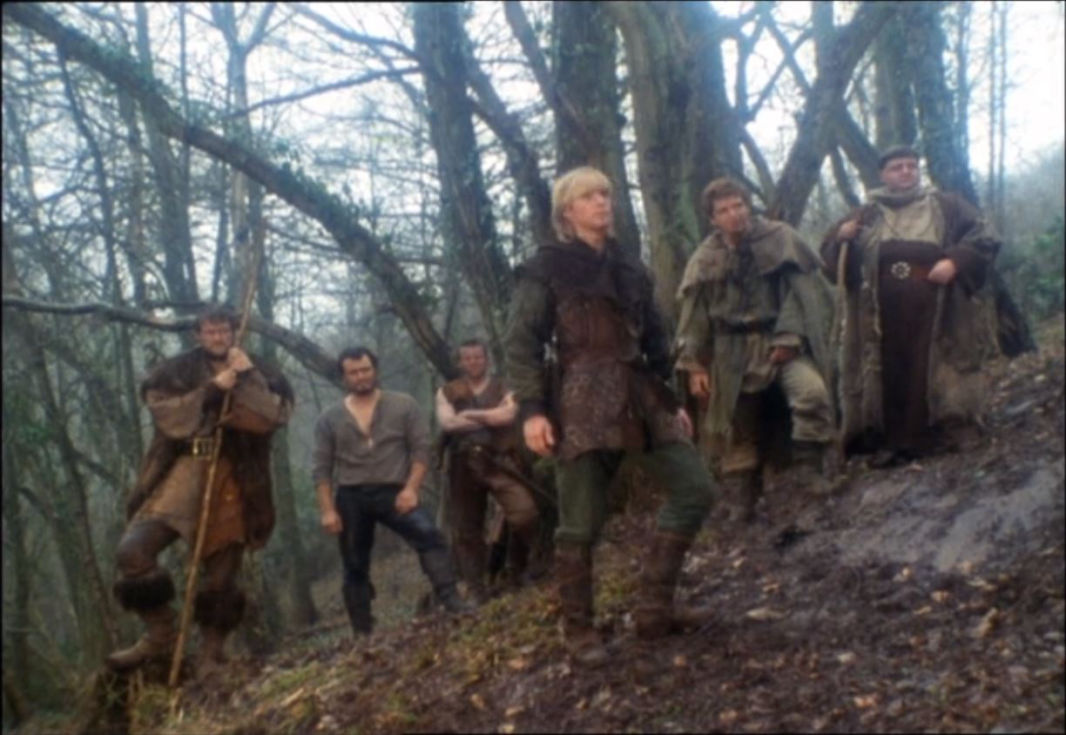
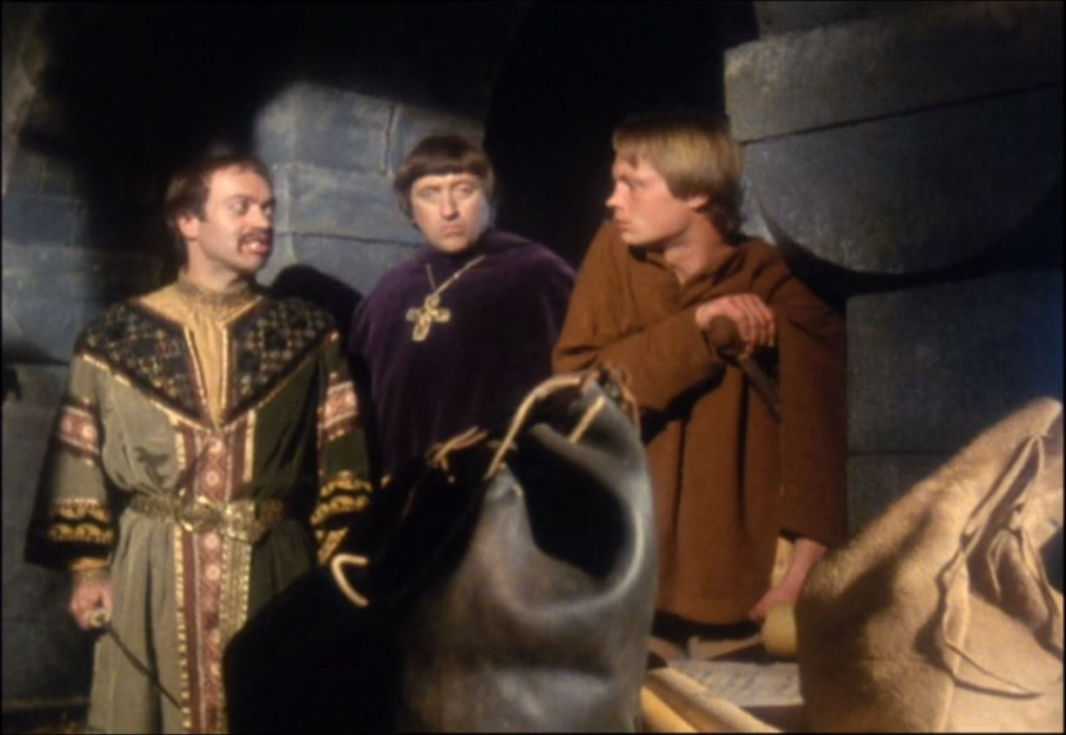
Herne's Son (Parts 1 and 2):
In 1569, Ralph Grafton wrote in his Chronicle at Large of an old pamphlet that said of Robin Hood "discended of a noble parentage: or rather beyng of a base stocke and lineage, was for his manhood and chiuarly aduanced to the noble dignitie of an Erle". In the 1590s, Elizabethan playwright chose Huntingdon (or Huntington as he spelled it) as Robin's earldom in the plays The Death of Robert, Erle of Huntington and The Death of Robert, Erle of Huntington. It has been a common alternative for Robin's background ever since. Robert of Huntingdon’s recruitment of the band evokes the classic “Robin Hood meets his match” formula of many ballads. He fights a quarterstaff duel with Little John as in the ballad (although not over water, as that had been done with Loxley’s first encounter). The encounter with Friar Tuck evokes the ballad Robin Hood and the Curtal Friar(and the play Robin Hood and the Friar) which has appeared elsewhere, such as in the Errol Flynn film and Howard Pyle and E. Charles Vivian’s children’s novels. The fights with Will Scarlet and Nasir also suggest the ballad formula. Sir Richard of Leaford’s debt to the abbot of St. Mary’s (including his mock begging for clemency before making repayment) comes from the early ballad A Gest of Robyn Hode. That story was used in many children’s novels, “The Knight Who Came to Dinner” episode of the 1955 Adventures of Robin Hood TV series starring Richard Greene and an episode of the 1975 BBC series The Legend of Robin Hood. Marian being rescued from an evil suitor is a common trope, including from Belame/Belleme in Vivian's novel and "Robin Hood and the Sorcerer".
The Power of Albion:
The pre-credits montage represents the typical view of Robin Hood in the late 20th century version of the legend. He robs a rich traveller, gives money to the poor and kills a forester. Robin rescues a poacher in many versions of the legend, particularly in film and television, which is discussed under Robin Hood and the Sorcerer where the motif appeared previously. Robin's dual role as a boorish nobleman and outlaw leader resembles the role Marian plays in some stories, most notably in the 1950s TV series The Adventures of Robin Hood. (Of course, there's a touch of The Scarlet Pimpernel and Zorro to Robert's deception, and the former was adapted to television by writer Richard Carpenter.) Marion also follows those earlier depictions of her character, helping the new Robin but only joining the band at the end of the episode. Marion's tensions with her father also resemble earlier treatments of the legend, perhaps most notably Thomas Love Peacock's 1822 novel Maid Marian. Marian also clashes with her uncle in the 1975 TV series The Legend of Robin Hood over her efforts to help Robin, and with her father in the 2006 Robin Hood series starring Jonas Armstrong and Lucy Griffiths.
The Inheritance:
The Robin Hood legend has been linked to the Arthurian legend on previous occasions, most notably in T.H. White’s novel The Sword in the Stone (collected as The Once and Future King). Little John’s interest in celebrating the Summer Solstice vaguely resembles the May Games often held around Pentecost in May or June where Robin Hood plays were often performed
The Sheriff of Nottingham:
Philip Mark actually was a 13th century Sheriff of Nottinghamshire and Derbyshire, one specifically mentioned in the Magna Carta. (A heroic, insufferably so, version of Philip Mark is the central character of Richard Kluger’s The Sheriff of Nottingham novel.) The idea of the regular bad guy being replaced by someone worse is a familiar trope, especially for Hogan’s Heroes. In an episode of the 1960s cartoon Rocket Robin Hood, the regular Sheriff of NOTT (National Outer-Space Terrestrial Territories) is similarly temporarily replaced and requires Robin’s help to get his job back. In “The Devil You Don’t Know” episode of the 1950s Adventures of Robin Hood TV series, Alan Wheatley’s sheriff is summoned to London while his newly appointed deputy played by John Arnatt appears to be an even more capable replacement. (The third season of BBC/Tiger Aspect’s Robin Hood series played a game of musical chairs with the sheriff’s job.)
Robin Hood rescues some of his men by impersonating a hangman in the ballad Robin Hood Rescuing Three Squires, and saves Little John with the same disguise in the fifth episode of the 1975 TV series The Legend of Robin Hood.
The Cross of St. Ciricus:
At a cast party someone remarked that as the only two blonds in the room, Jason Connery and Robert Addie could be brothers. That's where the idea for this episode came from. But the idea is not without precedent in the Robin Hood legend. Robin Hood: A Comic Opera by Reginald DeKoven and Harry B. Smith was a popular show in the late 19th and early 20th centuries. The sheriff tried to defraud Robert of Huntingdon of his lands and title by producing forged documents showing that Guy of Gisborne should be the true earl. (The sheriff was supposed to give Robert 100,000 crowns when he came into his inheritance. The sheriff offered Guy 50,000 crowns -- and Guy said he'd do it for 25,000 which the sheriff accepted. Also, Guy was willing to take only a tenth of the sheriff's dowry for Marian.).
Sheriff. (Speaking through music.) I find that by your father's will you are disinherited.
Robert. Disinherited?
Sheriff. (Producing document.) Here are the documents. Before your birth your father, the Earl, was secretly married to a young peasant girl. Their son was raised by me. Behold him -- the rightful heir of Huntingdon. (Pushes Guy forward.)
Sheriff. This statement's true. You cannot move it;
Here are the documents to prove it.Robert. This is some trick mendacious.
Sheriff. Not so; it is veracious.
Guy. Of course I am the real Earl.
Sheriff. Those papers prove his title quite.
(Aside., I made them all and know they're right.
The third series of the BBC/Tiger Aspect TV show plays with this idea of a blood tie between Robin and Guy when it establishes that Gisborne's mother had an affair with Robin's father. Robin and Guy aren't brothers in this production although they do share a half-brother named Archer.
Cromm Cruac:
As noted in the entry for "The Enchantment", there have been a few other instances where Robin Hood has fought magical enemies. This episode says Tuck was raised in Thornton Abby. The traditional home for Friar Tuck in the ballad Robin Hood and The Curtal Friar is Fountains Abbey. Otherwise, I'm at a loss on what to say about this episode.
The Betrayal:
The 14th century Old French prose romance of Fouke (or Fulk) Fitz Warin, a lord from the Welsh Marshes who turned outlaw and feuded with King John, has much in common with the Robin Hood legend, both medieval and modern. In one section a knight named Pieres de Brubyle assembled a band of robbers and committed terrible crimes while falsely claiming that he was Sir Fouke. "As a result, the real Fouke and his companions had acquired a very bad reputation for matters in which they were blameless." (from Thomas E. Kelly's modern English translation, p. 206 of Medieval Outlaws: Twelve Tales in Translation edited by Thomas H. Ohlgren. The real Fouke caught and beheaded the imposter.
In Sir Walter Scott's 1819 novel Ivanhoe, Front-de-Beouf and other Templar knights adopt the green garb of Robin Hood's outlaws when they ambush Sir Cedric's party. A similar plot device was also used in two 1950s version of the legend - the 1952 live-action Disney film The Story of Robin Hood and His Merrie Men and the "Queen Eleanor" episode of the 1955 TV series The Adventures of Robin Hood starring Richard Greene. Robin's exact double and Tuck's identical twin brother also made mischief in other episodes of the Greene series. However, the loopiest version of this trope may come in "The House Band", an episode of the 1975 comedy series When Things Were Rotten where the Sheriff finds exact doubles of all the Merry Men to blacken Robin's reputation.The same year a more tragic version of this trope appears in the final episode of the BBC TV series The Legend of Robin Hood. On the sheriff's orders, the friendly Bishop of Durham is murdered by thugs posing at Robin's men. This causes the villagers to hand the true Merry Men Ralph Gammon and Much over to Norman soldiers, and the heroes are promptly hanged without trial. I suppose it is convenient that Roger de Carnac and his gang happened to know that Marian and Much would be out of town, and that they didn't need to bother impersonating them. It does mean that the episode missed out on the false Marian trope from Ben Jonson's unfinished 17th Robin Hood play The Sad Shepherd and the 1967 film A Challenge for Robin Hood. King John's amorous attentions toward Marian (or Matilda, to use her real name) forms a large part of Anthony Munday's Elizabethan play The Death of Robert, Erle of Huntington.
Adam Bell:
Adam Bell is a central character in a once-popular medieval ballad -- Adam Bell, Clim of the Clough, and William of Cloudesley. (Click here for the scholarly introduction to the ballad.) William and Clim, Adam’s two compatriots, are of equal if not greater prominence in the medieval ballad but entirely missing from the episode. However, William and Clim do appear in the spin-off gamebook The Sword of the Templar. All three appear alongside Robin Hood’s men when some jokester added fictional outlaw names to a Parliamentary role in 1432. Robin Hood didn’t appear in Adam’s medieval ballad, which was set in Carlisle, Cumbria, but Adam and his friends were later incorporated into the Robin Hood legend. Robin Hood’s father proved himself a better archer than Adam, William and Clim in the later ballad Robin Hood's Birth, Breeding, Valour, and Marriage which set the precedent that Adam was older than Robin Hood. Adam and his friends continue to appear in various Robin Hood novels, such as Jennifer Roberson's 1992 novel Lady of the Forest. Children spent time with Robin Hood’s band in several episodes of the 1950s TV series starring Richard Greene including Marian’s unpleasant cousin in "The Youthful Menace"
The Pretender:
Isabella of Anglouleme and John's first wife Isabella of Gloucester (or Hadwisa as "The Pretender" calls her for clarity's sake) appeared in an episode of 1950s TV series The Adventures of Robin Hood starring Richard Greene ("Isabella") and the 2010 film starring Russell Crowe. John's young second wife also appears in the 1976 film Robin and Marian. A young Arthur of Brittany also appears in some episodes of the 1950s series including "The Youngest Outlaw" and "Ambush".
Rutterkin:
The family treachery visited on Earl David and Robin does have some legendary precendent. Brotherly disputes formed the basis of another medieval outlaw story, The Tale of Gamelyn and also Robin Hood is outlawed in the Elizabethan play The Downfall of Robert, Erle of Huntington by Anthony Munday and the 1967 film A Challenge for Robin Hood because he was betrayed by a relative. And while Mad Mab and Lord Edgar are both fictional, the historical Earl David of Huntingdon was indeed accused of being part of a plot to assasinate King John.
As noted elsewhere, Robin rescuing captured band members was both a common trope both this TV series and the actual ballads such as Robin Hood Rescuing Three Squires.
The Time of the Wolf (Parts 1 and 2):
As noted in the entry for "The Betrayal", the idea of doubles impersonating Robin Hood appears elsewhere in the legend (and even in this TV series) although usually the impostors don't have large comedy fangs as the one in this episode does.
Marion became a nun in this episode to allow her to return only as an occasional guest star if the show had been picked up for another season. But the idea of Marion as a nun does have precedent in the legend. In the Elizabethan play The Death of Robert, Erle of Huntington by Anthony Munday, Maid Marian (or Matilda as is the character's true name) seeks refuge in a convent and is later buried with the nuns at Dunmow Priory. In the 20th cetnury children's novel by Roger Lancelyn Green, the evil prioress of Kirkleys tricks Marian into believing Robin Hood has died and she takes holy orders. After Robin dies for real, Marian stays at Kirkleys, eventually becoming prioress herself. Marian is also the abbess of Kirklees in the 1976 film Robin and Marian (starring Jason's father Sean Connery as Robin Hood).
Also, Guy's wolfskin outfit resembles the horsehide he wears in the medieval ballad Robin Hood and Guy of Gisborne.
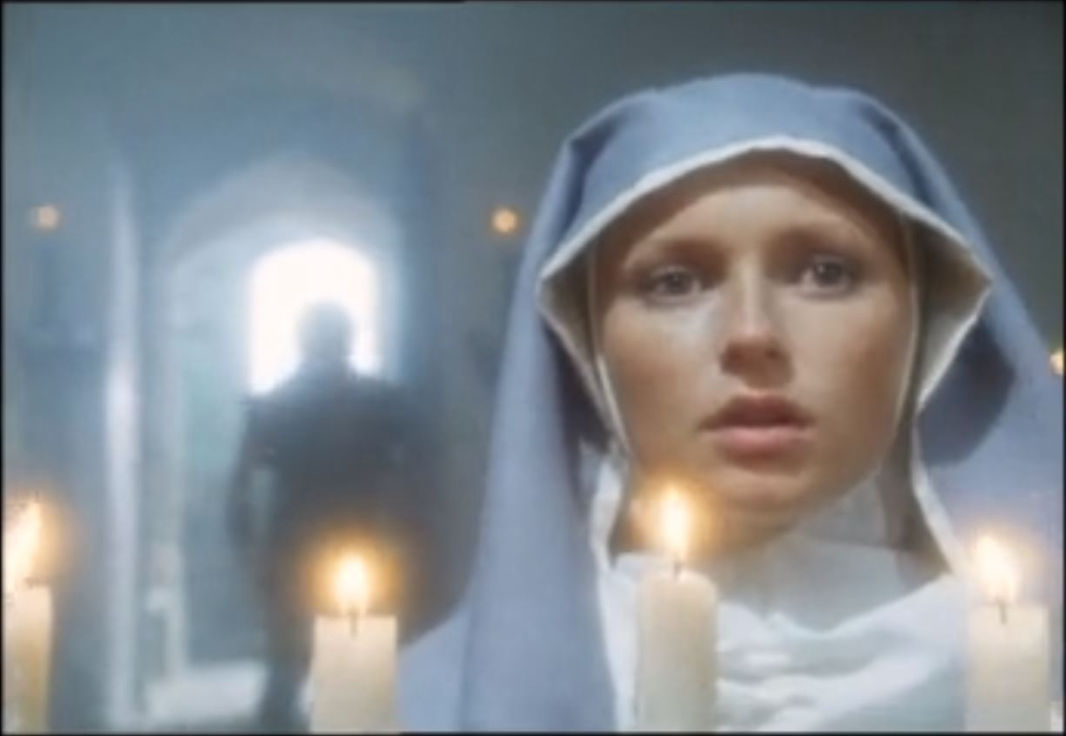
Contact Us